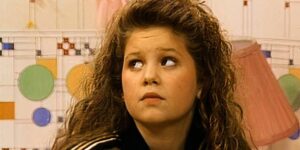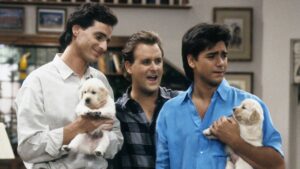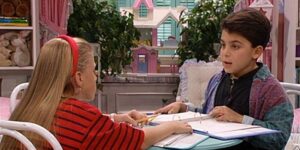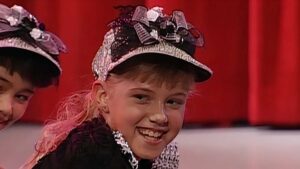
Full House is one of the most popular TV sitcoms of the late ’80s and all the ’90s. Millions of viewers tuned into ABC and later TBS and TeenNick to catch up with the Tanners. The show ran for eight seasons and 192 episodes and featured on-location shooting at beautiful locations like the Walt Disney Resort and Hawaii. The Beach Boys, Vanna White, Little Richard, and Phyllis Diller are among the famous names who made guest appearances. Later, a sequel called Fuller House was picked up by Netflix. Needless to say, Full House was a huge success for creator Jeff Franklin.
The appeal of the show is in its family-friendly entertainment. Despite the cheesy life lessons, there’s a lot of heart and comedic scenes in Full House that make it stand up even today. The cast has a ton of chemistry as well, which makes every moment among the family feel believable. While everyone could relate to the life moments in the show, Full House was particularly appealing to children who didn’t grow up in conventional households. Every season has its standout episodes, but some seasons are stronger than others.
8 Viewers Fell in Love With the Tanners in Season One (1987-88)

It’s tough to imagine Full House without the charmingly awkward Danny Tanner as the outstanding TV show dad. Surprisingly, the show’s creator, Jeff Franklin, originally had a different man in mind for the job, a successful comedian in the ’80s named Paul Reiser. When Reiser turned down the role, Franklin and the casting department found a replacement in Bob Saget. This was the right call since Saget brings a lot of heart to the role. This heart is the centerpiece for season one of Full House and puts the show on the right track for the future.
The pilot season of a TV sitcom is typically not as strong as the rest of the seasons. The same holds true for Full House. Danny Tanner is not yet a neat freak, and he works as a sports broadcaster for the local news rather than having his own show, “Wake Up San Francisco.” D.J. is a little too jealous of her sisters and eager to please, and it’s hard not to talk about Uncle Jesse’s “mop on top” mullet haircut. Meanwhile, the show doesn’t yet have Rebecca Donaldson and Kimmy Gibler isn’t quite yet the quirky neighbor she becomes later. Season one is still entertaining and pleasant to watch, but it isn’t nearly as good as the later seasons.
7 Full House Was Coming to an End in Season Eight (1994-95)
Audiences watched all three Tanner girls grow up on the screen. In season eight, D.J. was a senior in high school, Stephanie was a teenager, and Michelle was 8-years-old. It was still enjoyable to watch these characters on screen, but they were no longer the sweet little girls they had been before. The dynamic between the characters shifted, with new additions like Viper, Nelson, and Duane making their debut. At this point, actors Candace Cameron Bure (D.J.) and John Stamos (Uncle Jesse) were also burned out and ready to move on from filming the sitcom.
By the final season of Full House, all the characters were growing up. It started to feel implausible that Jesse, Rebecca, Nicky, and Alex would keep living upstairs in the attic. D.J. was also getting ready to spread her wings and fly by attending college. The show wouldn’t be the same without any of these characters, so it only felt natural for the eighth season to be the series finale. It’s too bad that the series ended with the two-parter, “Michelle Rides Again.” These final two episodes leave viewers on a bit of a cliffhanger with no real resolution. It feels like there’s still more to learn and more story to tell for all the characters. Despite this disappointing ending, the eighth season of Full House still has funny moments, a charming, feel-good holiday episode, and a memorable guest appearance by NBA superstar, Kareem Abdul-Jabbar.
6 The Characters Were Growing Into Their Own in Season Two (1988-89)

Whether it’s “Have mercy,” “Oh Mylanta,” or “How rude,” Full House is known for its iconic catchphrases. Some of these cute sayings are first heard in the second season of the show, which makes sense since the characters are starting to really come into their own. For instance, Uncle Jesse gets a haircut from “Mr. Stephanie” and no longer has his helmet-like mullet. Kimmy Gibbler, meanwhile, gets more of a character arc since Jeff Franklin decided to keep her on as a regular. It’s in season two that the Full House characters audiences know and love really get their chance to shine.
Toward the end of the season, Full House was finally starting to find its groove. Not only did Jesse’s parents become a funny addition to the show, but there were also new love interests and friendships such as Stephanie’s with Harry Takiyama. Episodes like “El Problema Grande de D.J.” and “Blast From the Past” give audiences a glimpse into how these relationship dynamics go wrong based on relatable circumstances. The two-parter, “Luck Be a Lady,” is also a fun watch, with Danny and Rebecca’s daytime TV show, “Wake Up San Francisco,” being filmed in Lake Tahoe. D.J. and Stephanie illegally gamble, and Rebecca and Jesse almost run off to get married. Overall, this season holds promise for what’s to come in the future for Full House.
5 The Tanners Felt Like a Real Family in Season Four (1990-91)
The genius of Full House is that the Tanners feel like they are really living as a family in San Francisco. Surprisingly, Candace Cameron Bure (D.J.) and Jodie Sweetin (Stephanie) as well as Bob Saget (Danny) and John Stamos (Jesse) didn’t get along in the early seasons. The fourth season was the midway point of the show’s run on television. The characters were fully realized, and even better, the actors were getting along. There was undeniable chemistry among the cast, and as a result, the family started to feel more authentic.
There’s no denying that D.J., Stephanie, and Michelle are cute, innocent blonde girls who are generally good kids. However, the fun in the show is that sometimes they make the same silly mistakes that kids make. For instance, in the episode “The Hole in the Wall Gang,” they accidentally put a hole through their dad’s bedroom wall. They go to great lengths to cover it up, even making up a song about their dad’s greatness. Another episode, “Crimes and Michelle’s Demeanor,” shows Michelle getting scolded for pinching back her preschool classmate, Aaron Bailey. It’s because the girls are sometimes getting in trouble and trying to get away with something that they become relatable. In these moments and in the discipline that follows, the Tanners feel more relatable.
4 Valuable Lessons Were Learned in Season Three (1989-90)

Part of the charm of Full House is the life lessons that are learned along the way. While seasons one and two dabble with these lessons, it’s really in season three where the music swells and Danny delivers his most profound “dad talks.” Season three also shows the family coming together to help each other out, whether it’s to host a telethon or to stop Rebecca and Jesse from breaking up. Each member of the Tanners has flaws and makes mistakes, but they have a loyal family behind them willing to back them up and help them make it through.
Every member of the Tanner family makes a big mistake in season 3 of Full House. Danny and Joey get arrested for trying to steal a seal from a sorority at their reunion. Michelle lets her class bird at preschool fly out the window. Worst of all, Stephanie accidentally drives Joey’s car through the kitchen. Viewers could relate to that gut-dropping feeling of getting in big trouble and laugh at the situation in the show. For the Tanners, there’s always a safety net since, no matter what happens, the family loves each other. A lesson is always learned, and their bond only grows stronger than ever, even in the midst of a crisis. Sometimes these lessons make season three of Full House feel overly sappy and cheesy, but for the most part, it’s still enjoyably watchable.
3 Full House Explored Serious Issues in Season Six (1992-93)

TV comedies don’t always last past the first few seasons. Full House defied the odds by still going strong when season six premiered in 1992. Arguably, viewers would have gotten bored of the wholesome family dynamics if new characters like Michelle’s friend, the older-than-his-years Derek Boyd, didn’t join the crew. The storylines, meanwhile, needed to become more grounded in reality in order to get the public’s attention. Full House rose to the occasion on both fronts, making season six one of the best in the show’s history.
In the early seasons of Full House, the family faces situations that mostly seem relatively simple and innocent. Season six kicks it up a notch by having the Tanners contend with real-world scenarios that can’t always be wrapped up in a pretty bow. In one of the most memorable episodes, “Silence is Not Golden,” Stephanie discovers that her classmate, Charles, has been the victim of child abuse, and she has to grapple with whether to say anything. While the solution to these types of issues is typically found pretty easily, and the residual impact of these lessons doesn’t last past the episode, it’s still refreshing to see the show tackle more mature subject matter. Viewers get to see that life for the Tanners isn’t as pure as it seems within the four walls of their San Francisco home.
2 Full House Started to Feel More Mature in Season Seven (1993-94)
Audiences all over the world had been welcomed into the Tanner household since 1987. Die-hard fans had started watching young and continued to watch even as they became preteens and teenagers. The show followed that growth by making its characters more mature and grown-up in the later seasons. With that in mind, it only made sense for Full House to later air on TeenNick between 2009 and 2017. It’s in seasons five through eight that the sitcom starts to really feel like a show for the 13 to 18-year-old demographic. The clothes the girls wear, the central lessons, and even new characters like Stephanie’s friend Gia all feel more mature, and this arguably makes the show a lot more entertaining.
It was in season seven of Full House that the comedy sitcom went from a family-friendly TV show to mature viewing for teen audiences. Kids grew up alongside D.J., Stephanie, and Michelle, and they were ready to see the Tanner girls deal with the same situations they were dealing with in their own lives. For instance, D.J. has a heart-to-heart with her dad about sex after she stays overnight at her boyfriend Steve’s apartment. Stephanie becomes the victim of the rumor mill at school and needs to squash the gossip with Gia’s help. Even Jesse has a coming-of-age moment when he realizes that his con artist cousin from Greece isn’t a good guy. When binge-watching the entire series, it’s evident that Full House is starting to lose steam in season seven. Still, there are many hilarious moments and good episodes worth viewing.
1 Full House Gives Its Characters Independence in Season Five (1991-92)

Full House reached its peak in season five. According to Nielsen ratings, this season had the highest number of viewers of the series. The Tanner family felt like they were comfortable and well-lived in their Victorian home or “Painted Lady” in San Francisco. Season five also introduced an array of likable new characters, including Danny’s girlfriend Vicky, the twins Nicky and Alex, and most notably, D.J.’s boyfriend Steve, a jock who is always raiding the fridge. Each Tanner feels like their own person, living their own lives, while still having the love and support of their family.
Season five stands out from the rest of the series since the characters are no longer playing off each other all the time. They begin to feel like they’re living independent lives within the family unit. By separating the lives of Danny, Jesse, Rebecca, and Joey from the lives of D.J., Stephanie, and Michelle, all viewers have someone that they can relate to when it comes to the stage they’re at in their own lives. Whether it’s D.J. arguing about her independence as she learns how to drive, or Jesse finding a way to live his dreams of being a musician even though he has twin boys. Fans will also feel fondly for the seasons that came before and after season five, but these twenty-six episodes will always have a special place in their hearts. It’s this season that helped cement Full House as one of the best TV sitcoms of the 1990s.
